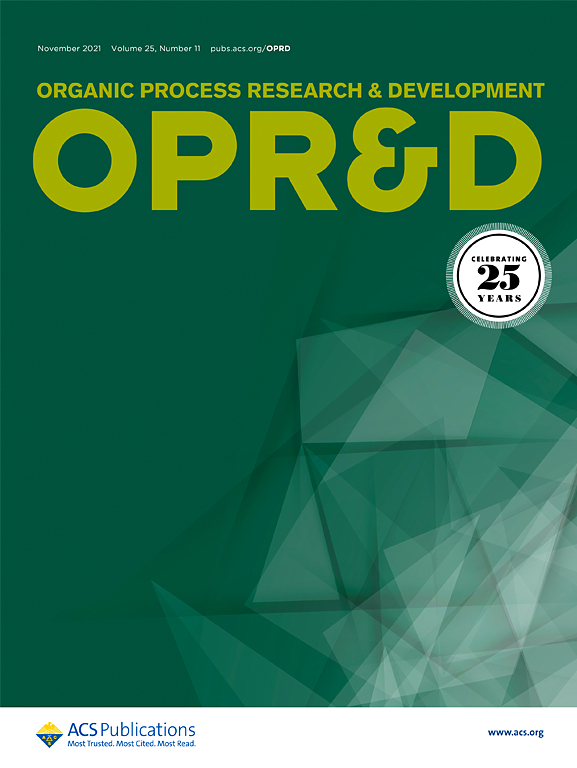Multistep Continuous Heterogeneous Synthesis of C.I. Reactive Red 195 and Safety Evaluation of the Continuous Diazotization Process
IF 3.1
3区 化学
Q2 CHEMISTRY, APPLIED
引用次数: 0
Abstract
Integrating the diazotization and coupling reactions in solid–liquid heterogeneous systems to achieve large-scale, multistep continuous flow synthesis of water-soluble azo dyes remains a significant challenge. During the diazotization process of water-soluble azo dyes, considerable diazonium salt may precipitate, posing potential safety risks. In this study, we established a continuous dynamic tubular reaction system to achieve the multistep continuous heterogeneous synthesis of C.I. Reactive Red 195, a representative water-soluble azo dye. The optimal conditions for continuous diazotization and coupling reactions were determined, achieving a high throughput of 120 L/h and a yield of up to 736 kg/day. The purity of the synthesized dye increased by 20% compared to the commercial C.I. Reactive Red 195, with the K/S value rising from 19.07 to 22.16, indicating enhanced dyeing performance. Density functional theory (DFT) calculations and ab initio molecular dynamics (AIMD) simulations show that 2-naphthylamine-1,5-disulfonic acid diazonium salt (NADA-DS) spontaneously aggregates into stable clusters due to dispersion forces, which leads to precipitation. Furthermore, the thermal stability, impact sensitivity, explosive propagation, and decomposition activation energy of NADA-DS were investigated. The severity and possibility of thermal runaway during the continuous diazotization process are classified as level 1. The risk matrix indicates that the continuous diazotization process risk is acceptable, with the Stoessel criticality diagram categorizing the hazard level as grade 1, signifying a low level of risk. This study promotes safer, more efficient, and sustainable production of water-soluble azo dyes.

多步连续多相合成C.I.活性红195及连续重氮化工艺的安全性评价
整合固液非均相体系中的重氮化和偶氮化反应,实现大规模、多步连续流合成水溶性偶氮染料仍然是一个重大挑战。水溶性偶氮染料在重氮化过程中可能析出大量重氮盐,存在安全隐患。本研究建立了连续动态管状反应体系,实现了水溶性偶氮染料C.I.活性红195的多步连续非均相合成。确定了连续重氮和偶联反应的最佳条件,达到了120 L/h的高通量和736 kg/d的产率。合成染料的纯度比市售C.I.活性红195提高了20%,K/S值从19.07提高到22.16,染色性能有所提高。密度泛函理论(DFT)计算和从头算分子动力学(AIMD)模拟表明,2-萘胺-1,5-二磺酸重氮盐(NADA-DS)在分散力作用下自发聚集成稳定的团簇,导致沉淀。研究了NADA-DS的热稳定性、冲击敏感性、爆炸传播和分解活化能。连续重氮化过程中发生热失控的严重程度和可能性为1级。风险矩阵表明,连续重氮化过程的风险是可以接受的,Stoessel临界度图将危害等级划分为1级,表示低风险水平。本研究旨在促进更安全、更高效和可持续的水溶性偶氮染料生产。
本文章由计算机程序翻译,如有差异,请以英文原文为准。
求助全文
约1分钟内获得全文
求助全文
来源期刊
CiteScore
6.90
自引率
14.70%
发文量
251
审稿时长
2 months
期刊介绍:
The journal Organic Process Research & Development serves as a communication tool between industrial chemists and chemists working in universities and research institutes. As such, it reports original work from the broad field of industrial process chemistry but also presents academic results that are relevant, or potentially relevant, to industrial applications. Process chemistry is the science that enables the safe, environmentally benign and ultimately economical manufacturing of organic compounds that are required in larger amounts to help address the needs of society. Consequently, the Journal encompasses every aspect of organic chemistry, including all aspects of catalysis, synthetic methodology development and synthetic strategy exploration, but also includes aspects from analytical and solid-state chemistry and chemical engineering, such as work-up tools,process safety, or flow-chemistry. The goal of development and optimization of chemical reactions and processes is their transfer to a larger scale; original work describing such studies and the actual implementation on scale is highly relevant to the journal. However, studies on new developments from either industry, research institutes or academia that have not yet been demonstrated on scale, but where an industrial utility can be expected and where the study has addressed important prerequisites for a scale-up and has given confidence into the reliability and practicality of the chemistry, also serve the mission of OPR&D as a communication tool between the different contributors to the field.

 求助内容:
求助内容: 应助结果提醒方式:
应助结果提醒方式:


